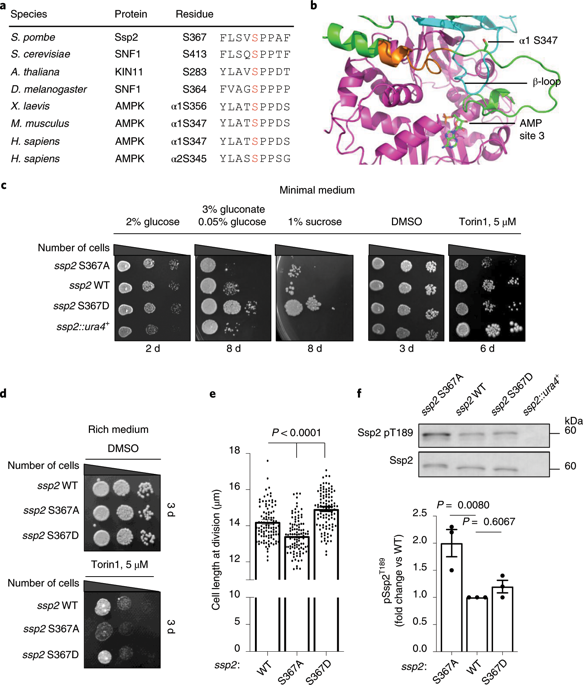当前位置:
X-MOL 学术
›
Nat. Metab.
›
论文详情
Our official English website, www.x-mol.net, welcomes your
feedback! (Note: you will need to create a separate account there.)
mTORC1 directly inhibits AMPK to promote cell proliferation under nutrient stress.
Nature Metabolism ( IF 18.9 ) Pub Date : 2020-01-20 , DOI: 10.1038/s42255-019-0157-1
Naomi X Y Ling 1 , Adrian Kaczmarek 2 , Ashfaqul Hoque 1 , Elizabeth Davie 3 , Kevin R W Ngoei 4 , Kaitlin R Morrison 2 , William J Smiles 1 , Gabriella M Forte 3 , Tingting Wang 2 , Shervi Lie 2 , Toby A Dite 1, 5 , Christopher G Langendorf 4 , John W Scott 4, 6, 7 , Jonathan S Oakhill 1, 6 , Janni Petersen 2, 3, 8
Nature Metabolism ( IF 18.9 ) Pub Date : 2020-01-20 , DOI: 10.1038/s42255-019-0157-1
Naomi X Y Ling 1 , Adrian Kaczmarek 2 , Ashfaqul Hoque 1 , Elizabeth Davie 3 , Kevin R W Ngoei 4 , Kaitlin R Morrison 2 , William J Smiles 1 , Gabriella M Forte 3 , Tingting Wang 2 , Shervi Lie 2 , Toby A Dite 1, 5 , Christopher G Langendorf 4 , John W Scott 4, 6, 7 , Jonathan S Oakhill 1, 6 , Janni Petersen 2, 3, 8
Affiliation

|
Central to cellular metabolism and cell proliferation are highly conserved signalling pathways controlled by mammalian target of rapamycin (mTOR) and AMP-activated protein kinase (AMPK)1,2, dysregulation of which are implicated in pathogenesis of major human diseases such as cancer and type 2 diabetes. AMPK pathways leading to reduced cell proliferation are well established and, in part, act through inhibition of TOR complex-1 (TORC1) activity. Here we demonstrate reciprocal regulation, specifically that TORC1 directly down-regulates AMPK signalling by phosphorylating the evolutionarily conserved residue Ser367 in the fission yeast AMPK catalytic subunit Ssp2, and AMPK α1Ser347/α2Ser345 in the mammalian homologs, which is associated with reduced phosphorylation of activation loop Thr172. Genetic or pharmacological inhibition of TORC1 signalling led to AMPK activation in the absence of increased AMP:ATP ratios; under nutrient stress conditions this was associated with growth limitation in both yeast and human cell cultures. Our findings reveal fundamental, bi-directional regulation between two major metabolic signalling networks and uncover new opportunity for cancer treatment strategies aimed at suppressing cell proliferation in the nutrient-poor tumor microenvironment.
中文翻译:

mTORC1直接抑制AMPK以促进营养胁迫下的细胞增殖。
细胞代谢和细胞增殖的核心是由哺乳动物雷帕霉素靶点 (mTOR) 和 AMP 激活蛋白激酶 (AMPK)1,2 控制的高度保守的信号通路,其失调与癌症和类型等主要人类疾病的发病机制有关。 2 糖尿病。导致细胞增殖减少的 AMPK 途径已得到充分证实,并且部分通过抑制 TOR 复合物-1 (TORC1) 活性发挥作用。在这里,我们证明了相互调节,特别是TORC1通过磷酸化裂殖酵母AMPK催化亚基Ssp2中的进化保守残基Ser367和哺乳动物同源物中的AMPK α1Ser347/α2Ser345来直接下调AMPK信号传导,这与激活环的磷酸化减少有关苏尔172。在 AMP:ATP 比率不增加的情况下,TORC1 信号传导的遗传或药理学抑制导致 AMPK 激活;在营养胁迫条件下,这与酵母和人类细胞培养物的生长限制有关。我们的研究结果揭示了两个主要代谢信号网络之间的基本双向调节,并为旨在抑制营养贫乏的肿瘤微环境中的细胞增殖的癌症治疗策略提供了新的机会。
更新日期:2020-01-20
中文翻译:

mTORC1直接抑制AMPK以促进营养胁迫下的细胞增殖。
细胞代谢和细胞增殖的核心是由哺乳动物雷帕霉素靶点 (mTOR) 和 AMP 激活蛋白激酶 (AMPK)1,2 控制的高度保守的信号通路,其失调与癌症和类型等主要人类疾病的发病机制有关。 2 糖尿病。导致细胞增殖减少的 AMPK 途径已得到充分证实,并且部分通过抑制 TOR 复合物-1 (TORC1) 活性发挥作用。在这里,我们证明了相互调节,特别是TORC1通过磷酸化裂殖酵母AMPK催化亚基Ssp2中的进化保守残基Ser367和哺乳动物同源物中的AMPK α1Ser347/α2Ser345来直接下调AMPK信号传导,这与激活环的磷酸化减少有关苏尔172。在 AMP:ATP 比率不增加的情况下,TORC1 信号传导的遗传或药理学抑制导致 AMPK 激活;在营养胁迫条件下,这与酵母和人类细胞培养物的生长限制有关。我们的研究结果揭示了两个主要代谢信号网络之间的基本双向调节,并为旨在抑制营养贫乏的肿瘤微环境中的细胞增殖的癌症治疗策略提供了新的机会。

































 京公网安备 11010802027423号
京公网安备 11010802027423号